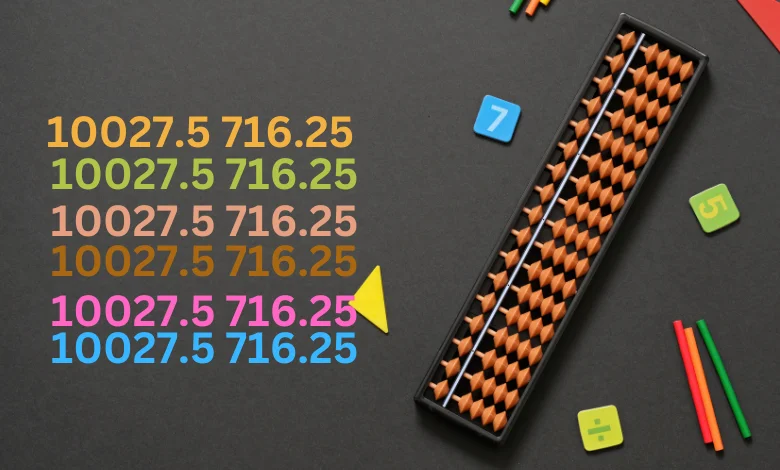
Numbers are everywhere, shaping our world in ways we often overlook. Among them, some stand out due to their unique properties or applications. Today, we’re diving into the intriguing realm of two specific figures: 10027.5 and 716.25. What do these numbers represent? Why should they matter to you? Join us as we unravel their mysteries and uncover the significance behind these digits that might just change your perspective on how you view numbers in everyday life. Let’s embark on this journey of decoding the numbers!
What is 10027.5 and 716.25?
The numbers 10027.5 and 716.25 may seem arbitrary at first glance, but they hold unique meanings in various contexts.
10027.5 could represent a precise measurement or calculation in fields like engineering, finance, or data analysis. Such specificity often plays a crucial role in decision-making processes.
On the other hand, 716.25 might denote an average value or a statistical point of interest within research studies or surveys. These types of figures can help us understand trends and patterns over time.
Both numbers can act as vital indicators for professionals who rely on accurate metrics to drive their work forward. Whether you’re working with finances or analytics, grasping what these values signify is essential for achieving outcomes that matter most to you.
The Significance of These Numbers
The numbers 10027.5 and 716.25 may seem random at first glance, but they hold significant meaning in various contexts.
In finance, for instance, the first number could represent a total revenue figure or an investment return that has a profound impact on future planning. Such data points can guide businesses toward better decision-making.
Meanwhile, the second number might connect to measurements in scientific research or engineering projects. Precision is crucial; even small discrepancies can lead to vastly different outcomes.
These figures also resonate within personal life scenarios—like budgeting or measuring physical spaces for home improvement projects—which underscores their relevance beyond mere statistics.
Understanding these numbers opens the door to deeper insights across multiple fields and applications. They are not just digits; they tell stories shaped by context and usage.
The Mathematical Breakdown
To understand 10027.5 and 716.25, we can start with basic arithmetic operations.
When you add these two numbers together, the sum is an intriguing 10743.75. This figure might seem random at first glance but could represent a total in various contexts.
Now, let’s look at multiplication. If you multiply 10027.5 by 716.25, the result is around 7,178,843.75. Such large numbers often appear in financial reports or data analysis.
Dividing one number by the other offers yet another perspective; dividing 10027.5 by 716.25 gives approximately 13.98—a ratio that may be useful for comparing quantities or assessing performance metrics.
These mathematical relationships reveal how interconnected seemingly unrelated figures can be when placed into context.
Real-Life Applications of These Numbers
Numbers like 10027.5 and 716.25 find their way into various aspects of everyday life, often unnoticed.
For instance, in finance, precise figures are vital for budgeting or investment calculations. A figure such as 10027.5 could represent a total expenditure or revenue projection.
In the realm of engineering, measurements matter immensely. The length of materials might require specific dimensions like 716.25 millimeters to ensure accuracy when constructing structures.
Health and fitness also utilize these numbers frequently; they might indicate calorie counts or distances run during training sessions.
Even in tech development, these values can represent data points or system specifications crucial for performance optimization.
Understanding how to decode such numbers enhances our ability to navigate daily tasks more efficiently while making informed decisions across various fields.
How to Use These Numbers in Daily Life
Numbers like 10027.5 and 716.25 can be surprisingly useful in everyday situations. For instance, if you’re budgeting for a project or planning an event, these figures might represent expenses or quantities.
When engaging with data analytics, understanding how to interpret numbers like these can lead to informed decision-making. They could indicate performance metrics or sales targets.
In cooking, precise measurements matter too. If a recipe calls for 716 grams of an ingredient, knowing how to convert that into smaller units can help achieve the desired taste.
Fitness enthusiasts may find value as well; tracking distances in kilometers often involves decimal points similar to 10027.5 when noting long runs or bike rides.
By integrating such numerical insights into your daily tasks, you enhance accuracy and efficiency across various aspects of life.
Conclusion
Numbers often tell a story. They speak to us, whether we realize it or not. When we examine 10027.5 and 716.25 closely, they reveal layers of meaning and significance.
Understanding these figures goes beyond mere mathematics; it’s about recognizing their relevance in our lives. From finance to statistics, the applications are vast and varied.
Each number has its mathematical properties that shape how we interpret them within different contexts. Their breakdown opens doors to deeper insights into patterns and relationships.
Using numbers like these daily can enhance decision-making skills, boost analytical thinking, and improve overall financial literacy.
Embracing the essence of numbers enriches our experiences, grounding them in logic while expanding our creative horizons when interpreting data around us.













